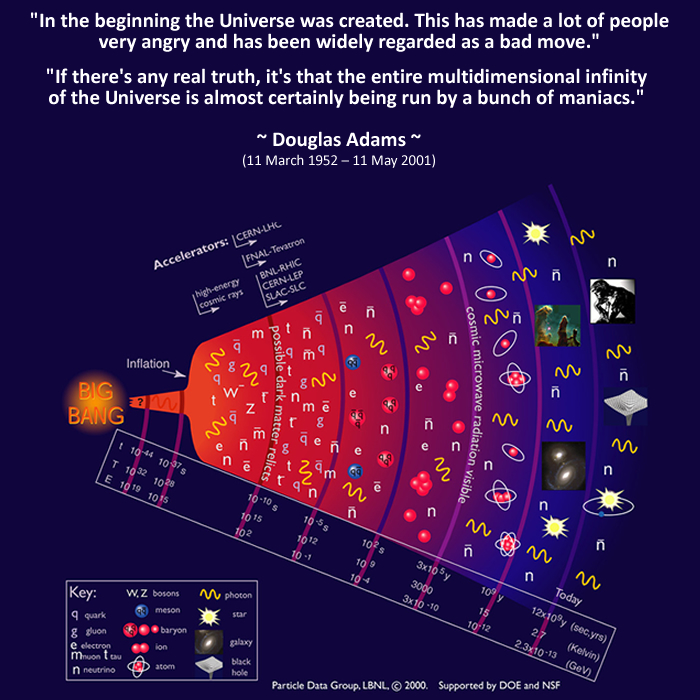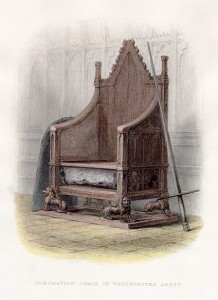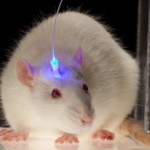Republished by Blog Post Promoter
“IT IS IMPOSSIBLE TO ESTIMATE THE ABILITY OF ARTISTS TO INVENT AN AESTHETIC TO MASK THE PRESENCE OF EVIL.”
— Lawrence R. Spencer, 2012 —
miscellaneous postings by Lawrence R. Spencer
Republished by Blog Post Promoter
“IT IS IMPOSSIBLE TO ESTIMATE THE ABILITY OF ARTISTS TO INVENT AN AESTHETIC TO MASK THE PRESENCE OF EVIL.”
— Lawrence R. Spencer, 2012 —
Republished by Blog Post Promoter
 Everything we know, and need to know, to understand “the universe(s)” was stated simply and precisely by Douglas Adams. As one maniac to another, I think the universe is what we agree it is. – Lawrence R. Spencer
Everything we know, and need to know, to understand “the universe(s)” was stated simply and precisely by Douglas Adams. As one maniac to another, I think the universe is what we agree it is. – Lawrence R. Spencer
“In the beginning the Universe was created. This has made a lot of people very angry and has been widely regarded as a bad move.”
“If there’s any real truth, it’s that the entire multidimensional infinity of the Universe is almost certainly being run by a bunch of maniacs.”
Republished by Blog Post Promoter
The Queen of England is the “divine” embodiment of The Church and The State: The Big Priest and The Big Politician combined! (What a bargain, huh?)
The divine right of kings, (and QUEENS) or divine-right theory of kingship, is a political and religious doctrine of royal and political legitimacy. It asserts that a monarch is subject to no earthly authority, deriving his right to rule directly from the will of God. The king is thus not subject to the will of his people, the aristocracy, or any other estate of the realm, including (in the view of some, especially in Protestant countries) the Church. According to this doctrine, only God can judge an unjust king. The doctrine implies that any attempt to depose the king or to restrict his powers runs contrary to the will of God and may constitute a sacrilegious act.
The remote origins of the theory are rooted in the medieval idea that God had bestowed earthly power on the king, just as God had given spiritual power and authority to the church, centering on the pope. The immediate author of the theory was Jean Bodin, who based it on the interpretation of Roman law. With the rise of nation-states and the Protestant Reformation, the theory of divine right justified the king’s absolute authority in both political and spiritual matters. The theory came to the fore in England under the reign of James I of England (1603–1625, also James VI of Scotland 1567–1625). Louis XIV of France (1643–1715), though Catholic, strongly promoted the theory as well.
 The “Divine Right” of royalty is bestowed during the coronation ceremony while the monarch is perched on a throne which houses the “STONE OF DESTINY“. In origin, the Stone is believed to have been “Jacob’s Pillow”, referring to the Biblical story in which Jacob falls asleep on a stone and has a dream in which he sees angels descend and ascend to Heaven. It is during this mystical appearance that he utters the phrase: “How terrible is this place! This is none other then the house of the Lord and this is the gate of heaven.”
The “Divine Right” of royalty is bestowed during the coronation ceremony while the monarch is perched on a throne which houses the “STONE OF DESTINY“. In origin, the Stone is believed to have been “Jacob’s Pillow”, referring to the Biblical story in which Jacob falls asleep on a stone and has a dream in which he sees angels descend and ascend to Heaven. It is during this mystical appearance that he utters the phrase: “How terrible is this place! This is none other then the house of the Lord and this is the gate of heaven.”
One tradition states that the stone Jacob used as a pillow at Bethel was then set up as a pillar and anointed with oil and that later, it became the pedestal of the Ark in the Temple of Solomon in Jerusalem. But that is just one strand of the legend.
Jacob’s story is also very similar to Wolfram von Eschenbach’s description of the Grail Stone… and it is not the only parallel. For one, Wolfram’s account speaks of a mythical stone, set somewhere on Earth, and equally links it with the ascent and descent of the angels. He also sees this Grail Stone as part of the Covenant between Mankind and God, not unlike the Jewish Ark of the Covenant. And it was this Ark that was the expression of the unity of the Jewish tribes, and their special bond with God.
The British Queen or King is, of course, even without the Stone, one of the few remaining heads of State that is also the Head of the Church. And thus, the Stone, whether real or merely symbolic, continues to play a key role in a tradition of sacred kingship, which in the 21st century has become extremely rare. (Phillip Coppens)
If you are dim-witted enough to fall for all this “Divine” monarch baloney, you deserve what you get: perpetual economic slavery, treachery, villainy and ruin.
God Save Us From The Queen!
(for more details visit The Daily Mash — http://www.thedailymash.co.uk/ )
Republished by Blog Post Promoter
Republished by Blog Post Promoter
If you read the book ALIEN INTERVIEW, you know that humans on Earth are given amnesia and false memories between each incarnation or lifetime.  Thanks to modern “science”, we may soon be implanted with MORE FALSE MEMORIES while we are sleeping! Earth “scientists” have now demonstrated (using laboratory mice) that they can make us all feel “happy” about being imprisoned on Earth. Remember the films “Total Recall” from 1990 or 2012? The “science” in these so-called “science fiction” films will soon to become what we call “reality”. In other words, you may be “happy”, but you won’t know who you are, where you are, when you are, why you are, or what is or isn’t real.
Thanks to modern “science”, we may soon be implanted with MORE FALSE MEMORIES while we are sleeping! Earth “scientists” have now demonstrated (using laboratory mice) that they can make us all feel “happy” about being imprisoned on Earth. Remember the films “Total Recall” from 1990 or 2012? The “science” in these so-called “science fiction” films will soon to become what we call “reality”. In other words, you may be “happy”, but you won’t know who you are, where you are, when you are, why you are, or what is or isn’t real.
Read the article below, and the links to other articles on the subject published in The Guardian
“Researchers at CRNS (click here to see a list of the Global Corporations who fund the research done at The National Center for Scientific Research) in Paris create artificial positive feelings in mouse’s memory for first time during sleep, highlighting possible new treatment for depression. Scientists have succeeded in creating false but happy memories in mice, in the first demonstration of memory manipulation during sleep.
In the study, positive feelings about a particular place were artificially written into the animal’s memory, which caused them to seek out that place in search of a reward when they woke up. The discovery that emotional memory can be readily manipulated has echoes of the the film, Eternal Sunshine of the Spotless Mind, in which Jim Carey’s character has every recollection about his failed relationship wiped clean using a fictional mind-reading technology.
The scientists say that the findings could pave the way for new treatments that would allow patients to overcome depression or deeply entrenched painful memories. Karim Benchenane, the neuroscientist who led the research at the CNRS in Paris, said: “The idea is to use this as a tool for post-traumatic stress disorder.”
Steve Ramirez, a neuroscientist at Massachusetts Institute of Technology who is also working on memory manipulation, described the research as a “technical tour-de-force”. He said: “It demonstrates a little bit of mastery over how the brain works. “In future it should be possible to dampen the punch of traumatic memories in people.”
 In the study, scientists implanted two electrodes in the brains of mice – one in a region of the hippocampus, the brain’s memory centre, involved in mapping locations and the second one in the brain’s reward centre.
In the study, scientists implanted two electrodes in the brains of mice – one in a region of the hippocampus, the brain’s memory centre, involved in mapping locations and the second one in the brain’s reward centre.
In both mice and humans, our environment is physically mapped out in the brain by so-called “place cells”, which light up like coordinates on a grid as we move through space. The scientists picked a particular place cell neuron and observed which location it related to in real-life as the mouse roamed around a large exploration area.
During sleep, mice typically replay these sequences of place cell activity – effectively their memory replaying where they have been during waking hours. The scientists rigged up the electrodes, such that during sleep, whenever the target place cell became active it triggered the delivery of a reward stimulation in the second electrode.
Advertisement
Although the memory of the place was initially neutral, during its sleep, the mouse learned to associate it with something positive happening.
“When they woke up the mouse went straight to that place as though it was waiting for a reward,” said Benchenane.
The study demonstrates what we subjectively know to be true — that the factual content of our memories and the emotional content are stored in different brain centres and can be changed independently.
 Benchenane believes the findings could be the basis for a non-invasive tool for memory manipulation in humans. Rather than electrodes, functional MRI scans could be used to identify when a person is replaying a specific memory during sleep, he suggested.
Benchenane believes the findings could be the basis for a non-invasive tool for memory manipulation in humans. Rather than electrodes, functional MRI scans could be used to identify when a person is replaying a specific memory during sleep, he suggested.
However, the authors said they would be cautious about rushing to try and test this in PTSD patients. “It might be extremely dangerous to get a reward for something fearful,” he said.
Ramirez agreed that in future, the findings could have clinical applications. “The big thing technologically is we don’t have a good non-invasive way of manipulating brain activity. One day it should be possible though,” he said.”
http://www.theguardian.com/science/2013/jul/25/false-memory-implanted-mouse-brain